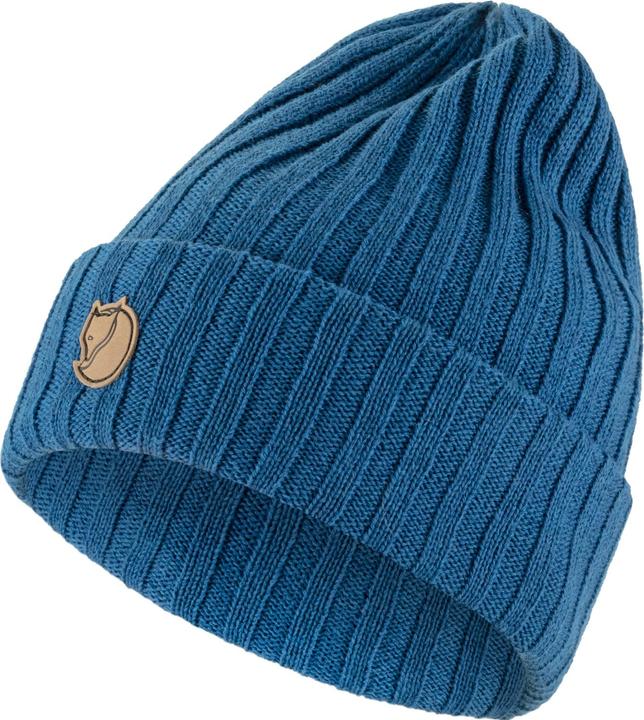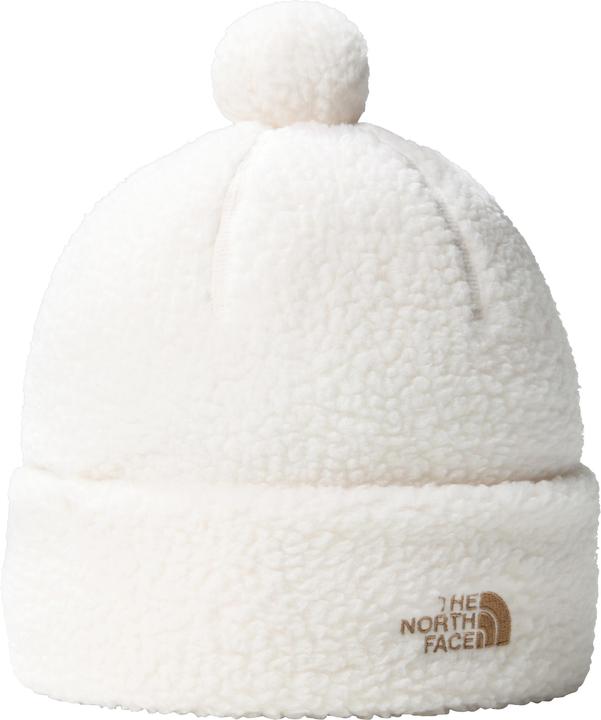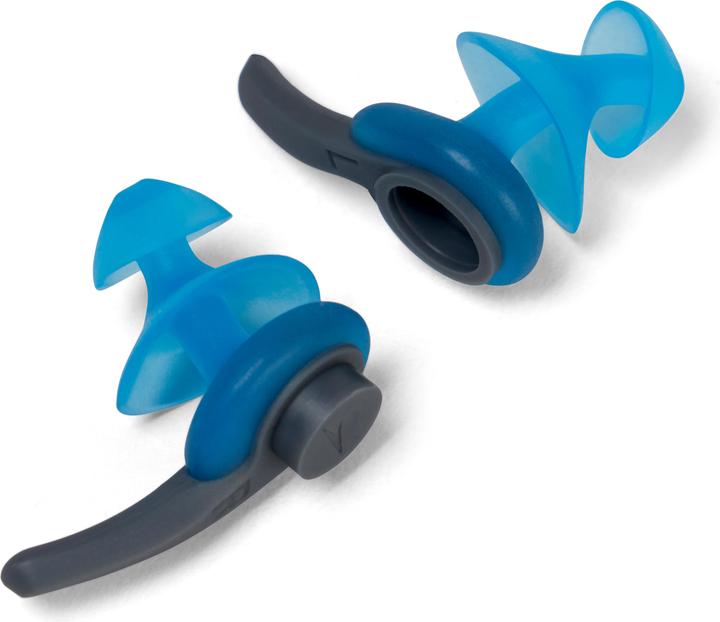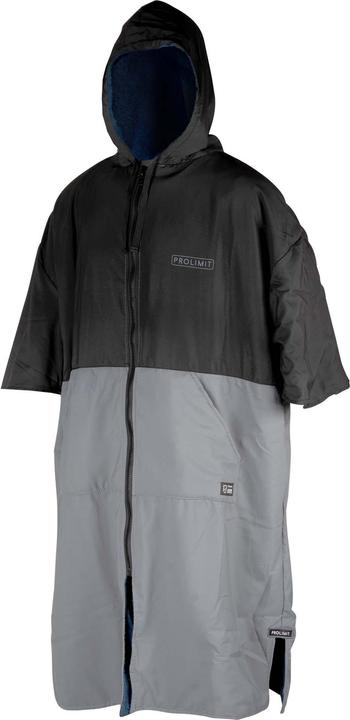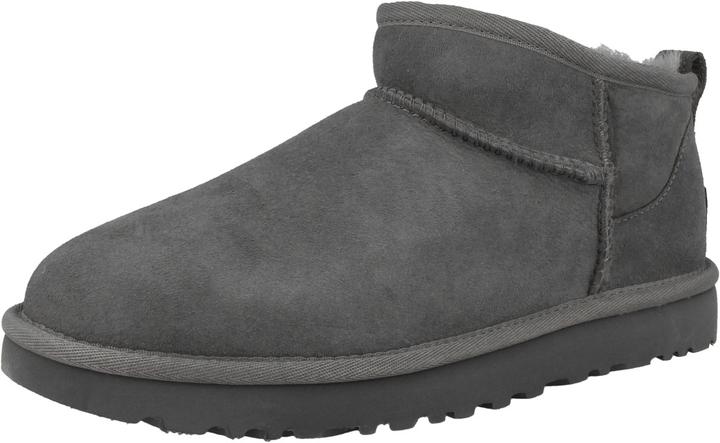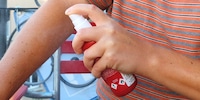
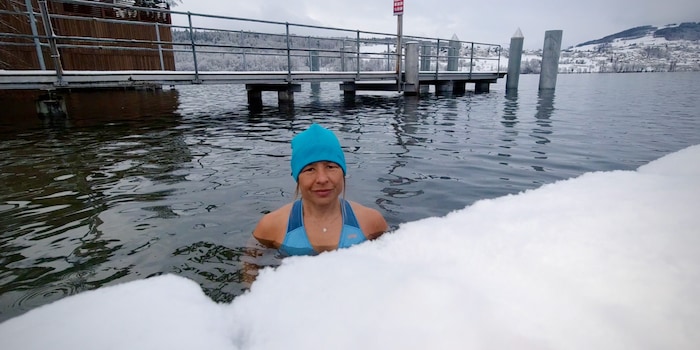
Winter swimming can be cool and fun, just stay alert
The temperatures of Swiss lakes are falling. For many, this marks the end of the swimming season. However, for winter swimmers, the water turning cold brings joy. Read on to find out what you need to look out for when taking part in this winter activity.
Anyone who has taken a walk along the Swiss lakeshore in winter in recent years has probably seen them: winter swimmers who venture into the ice-cold water – shivering, swearing or squealing with delight.
Since swimming or bathing in cold water isn’t an everyday occurrence, people react to the hype in very different ways. Some think it’s fantastic because of the endless health benefits, others think it’s complete garbage. As is often the case, the truth lies somewhere in between. Winter swimming is neither a magic remedy for all kinds of ailments, nor is it a hobby for selfie-obsessed influencers that’s sure to end badly.
If you’re planning to start cold training this winter, now is the best time. Temperatures in Swiss lakes are still bearable and you can gradually get your body and mind used to more extreme conditions. Just try to stay in the water for a few minutes at water temperatures between 10 and 15 degrees and breathe calmly. If you do this regularly once or twice a week, you can prepare your body and mind for temperatures below ten degrees. In January and February, the water is often only two to four degrees cold and sharp ice can form on the surface. Of course, you can still start winter swimming then, but it’s much harder. No matter when you start, here are ten tips and things to look out for.
1. Cold water swimming is fun, but risky
Despite all the fun that a dip in the cold water can offer, I have to say a few words about the risks first. Hypothermia is a real danger and can lead to cardiac arrhythmia, unconsciousness and drowning. Therefore, always make sure that you’re not staying in the water for long and don’t go alone. Unfortunately, there’s no rule of thumb for how long you should stay in the water, so it’s all the more important to approach winter swimming with caution. Neither the time nor your own feelings are reliable guides to go by. This is because the time you can stay in the water relatively safely depends on your daily condition, your body composition, how much you’ve eaten and drunk and other factors. From my own experience, I can say that cold water can suddenly feel very comfortable, especially when you get into the danger zone. So it’s better to get out of the water sooner rather than later. After 30 minutes, the risk increases significantly. And those who rely on the health-promoting effects of cold training, such as less tension and a better mood, will reap most of the benefits in the first few minutes anyway.
2. Habituation reduces the gasp reflex
Anyone who has ever ventured into cold water will be familiar with this: breathing takes on a life of its own and increases to the point of hyperventilation. This increases the risk of inhaling water and drowning. However, you can get used to the cold stimulus by taking cold showers and bathing in cool – not cold – water. This will allow you to have a better and faster control of your gasping. It really helps to consciously concentrate on your breathing, especially in the first 90 seconds.
3. Enter the water slowly
When we immerse ourselves in cold water, the blood vessels in our arms and legs, the so-called peripheral blood vessels, contract in order to concentrate heat in the body’s core. This causes a rapid and massive rise in blood pressure. This can lead to dizziness and a feeling of weakness. As dizziness and unconsciousness are dangerous in deep water, wading in slowly is essential. Jumping in can have fatal consequences for the same reason. As the first 90 seconds are considered the riskiest due to the sudden rise in blood pressure and the gasp reflex in cold water, it’s advisable to spend them standing with other people in relatively shallow water.
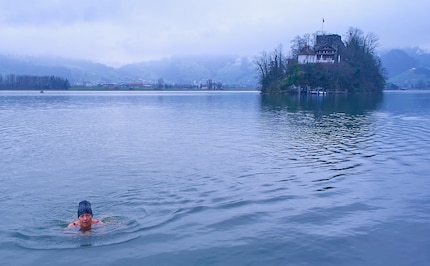
Source: Stefan Munsch
4. What clothing is suitable?
When it comes to swimwear in the cold, there are two camps: some swear by neoprene, while others wear little in swimming trunks or a bikini. This is down to personal preference and depends on how long you want to stay in the water. A wetsuit allows you to swim for longer, it also provides some buoyancy, but does not protect you from the cold-water shock when you first dive in.
Swimming trunks or a bikini provide a more intense and direct cold experience. I prefer a bikini for another reason. I find it almost impossible to take off the wetsuit with cold, frozen fingers. It’s important to change and dry quickly to get warm again, so I opt for swimwear that can be changed quickly, such as a bikini. I like to put on a neoprene hat, even though it’s a myth that we lose 80 per cent of our body heat through our heads. If you’re sure that your head will stay dry, you can also wear a warm woolly hat. Or a cosy fleece beanie.
5. Enjoy and don’t break any records
They do exist, ice swimmers who train for the Ice Mile or the World Ice Swimming Championships (an interview with a medal winner will follow). But if you’re just starting out with ice bathing or swimming, you should take it slowly and enjoy it. The feeling of elation that sets in after you’ve been in the water for two minutes doesn’t get any better if you’ve been cramped and trembling for longer. The opposite in fact.
6. Bathing or swimming?
Many enjoy the cold water while standing, concentrating on their breathing and their thoughts and feelings. Others love to go in a few metres and lie back.
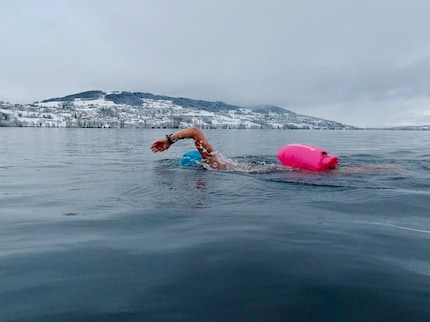
Source: Siri Schubert
Swimming in cold water carries a number of risks that go beyond those of cold water swimming, also known as dipping. While a thin layer of water warms up around your body when you stand in cool water, fresh, cold water constantly flows past you when you swim. As the blood flow to the muscles in your arms and legs is reduced, your strength and coordination decrease. In the worst-case scenario, you can’t swim any more. So stay close to the shore and look for an easy place to get out, because even climbing onto a jetty, which is otherwise no problem, can become impossible in the cold – I’ve experienced this myself.
Even if I’m just a few metres from the shore, I have a buoy with me. It helps when I get a cramp, for example, or swallow some water and have to cough. As cold water in the ear can affect your sense of balance, I use special swimming earplugs. I also wear swimming goggles to protect my eyes from the cold.
7: Beware of the afterdrop effect
Another danger of winter swimming is the so-called afterdrop, i.e. the cooling of the body after you’ve come out of the water. In the past, it was believed to be caused by cold blood flowing back from the arms and legs to the heart. However, thanks to research by Professor Mike Tipton at the University of Portsmouth, we now know that – to put it simply – the outer, cooler layers of the body continue to release cold to the inside of the body for up to half an hour. If the core of the body becomes too cold, this can lead to cardiac arrhythmia and loss of consciousness and, in the worst case, can be fatal. Don’t push yourself to your limits when swimming in cold water, because once you leave the water, it gets even colder.
8. Change quickly, warm up slowly
Put on warm, dry and windproof clothing as soon as possible when you get out of the water. With an emphasis on «as possible». This is because as you get colder, your coordination decreases and getting dressed becomes an acrobatic challenge.
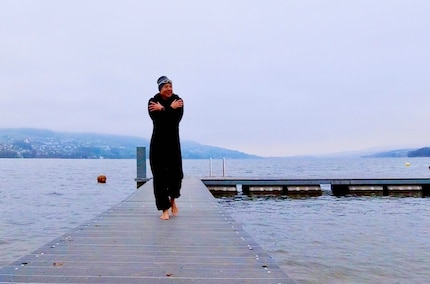
Source: Siri Schubert
I like to change into a windproof poncho with a cosy soft lining on the inside. I wear a warm overall for quick changes without fiddling with zippers and the like because it can be difficult to fasten buttons with ice-cold, numb hands. Getting shoes onto numb feet is also a real challenge. That’s why I like to wear lined, wide boots that I just have to slip into.
A hot shower or a hot bath after a cold-water swim, on the other hand, isn’t a good idea. The difference in temperature can cause your blood vessels to dilate very quickly and you may feel dizzy. A warm drink (I like to take ginger tea with me in a thermos flask) can do you good.
9. Warm shivering can help
Tremors are small muscle contractions that generate heat. They’re uncomfortable, but help you to get warm again. My colleague Anna Sandner has shed some light on the [trembling] phenomenon(page/warum-wir-zittern-von-schlotternden-knien-bis-schuettelfrost-29271). If you’re shaking a lot, your carbohydrate stores in your muscles will quickly run out. A sugary snack can help. In many winter swimming groups, having cake afterwards is a tradition. Even the magazine Outdoor Swimmer has already asked whether cake is the perfect food for open water swimmers. Tremors themselves are harmless. On the other hand, if someone is severely chilled but no longer shivering, this can be a serious warning sign that they require urgent medical attention.
10. Time to keep cool
Winter swimming is definitely a trend and if you want to try it, autumn is a good time to start. When the water is still above 10 degrees, you can slowly get used to the falling temperatures. Blind ambition however, is inappropriate. If you let winter swimming turn into a competition, it quickly becomes dangerous. The motto is to start gently and not force anything. There’s actually no need to go into cold water in winter, unless you really feel like it and feel that it’s good for you. If not, a brisk walk along the lakeshore in cool temperatures is probably just as beneficial to your health and much less risky.
Header image: Siri Schubert
Research diver, outdoor guide and SUP instructor – I love being in, on and around water. Lakes, rivers and the ocean are my playgrounds. For a change of perspective, I look at the world from above while trail running or flying drones.
Practical solutions for everyday problems with technology, household hacks and much more.
Show all